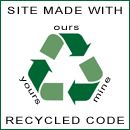Reference Question of the Week – 11/9/08
November 15th, 2008 Brian Herzog A patrons walks up to the desk, slides me this piece of paper, and says,
A patrons walks up to the desk, slides me this piece of paper, and says,
I was walking in the woods behind my house and found a plaque with this written on it. Can you tell me what it says?
He then elaborated saying the plaque was made of stone and the characters were painted onto it and it looked like an ancient language so he went online and found Omniglot.com and by looking at the alphabets there decided they must be Runic characters and in front of the plaque was a little container which he didn't open but he photographed the whole area and...
It took awhile before I could get a word in edgewise, but the longer he talked, the more it sounded to me like he had found either a letterbox or a geocache. When I did get a chance, I asked him a few more questions in this direction, and his answers made me feel I was on the right track.
He had never heard of letterboxing or geocaching, but after a quick explanation, he was interested. I told him that both were treasure-hunting activities, in which the participants follow either clues or GPS coordinates, and then have to solve puzzles, riddles or codes to find the "treasure."
I showed him the websites where many letterboxes and geocaches are registered, http://www.letterboxing.org, http://www.atlasquest.com, and http://www.geocaching.com. Since the "clue" he brought in was entirely encoded in Runic characters (a quick check on Wikipedia's Runic article and a couple books on Runes confirmed this), I guessed that this was a geocache, so we started there.
 We first tried searching by zip code, but that brought back too many results. Geocaching.com's advanced search also allows searching by coordinates, so we went to Google Maps and I had him show me as closely as possible where he found the plaque. By right-clicking on the location he pointed to and choosing the "Center Map Here" option, we zeroed in on his location. Then by hovering over the "Link" link on the top right of the map (circled in red), we could see the coordinates in the URL. It took a bit of trial and error to translate that into what the Geocaching.com search wanted, but eventually we figured it out (it's Decimal Degrees).
We first tried searching by zip code, but that brought back too many results. Geocaching.com's advanced search also allows searching by coordinates, so we went to Google Maps and I had him show me as closely as possible where he found the plaque. By right-clicking on the location he pointed to and choosing the "Center Map Here" option, we zeroed in on his location. Then by hovering over the "Link" link on the top right of the map (circled in red), we could see the coordinates in the URL. It took a bit of trial and error to translate that into what the Geocaching.com search wanted, but eventually we figured it out (it's Decimal Degrees).
When we searched on the those coordinates and click on the first result, the details and clues listed were also in Runic code, so we decided we were in the right place.
I didn't help the patron decode all the new clues, but we did work on the original sheet he brought it. It turned out to be the final clue for this cache, and was numbers spelled out (as in, N-I-N-E), which I think were the final coordinates a geocacher needed to plug into their GPS unit to find the cache.
The patron was both happy with this decoding, and interested in this new activity. I've done both geocaching and letterboxing, so it was fun to share some information from personal experience.
